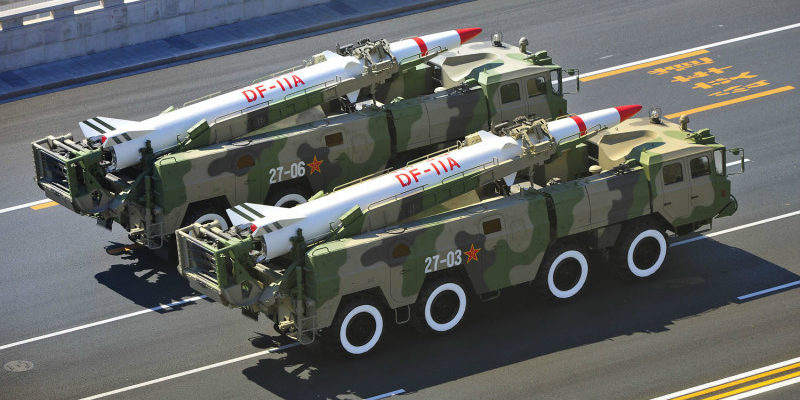Facts
| PRC/U.S. Designation | Dong Feng-11 (DF-11)/CSS-7 |
| Missile Variants | M-11/CSS-7 Mod 2 |
| Mobility and Role | Road-mobile/Short-Range Ballistic Missile |
| Designer/Producer | People’s Republic of China |
| Range | 280-300km[i] |
| Warhead Type and Weight | Conventional, Nuclear/800kg[ii] |
| MIRV and Yield | No MIRV capabilities/350kT[iii] |
| Guidance System/Accuracy | Inertial/200m CEP |
| Stages/Propellant | Single/Solid |
| IOC/Retirement | 1995[iv]/N.A. |
| Status/Number of Units | Operational/2-5 launchers; 100-300 missiles “est”[v] |
Overview
The Dong Feng-11 (DF-11) is a road-mobile, nuclear-capable, short-range ballistic missile (SRBM) developed by the People’s Republic of China (PRC). A solid-fuel SRBM launched from a transporter erector launcher (TEL), the DF-11 can be launched with roughly 30 minutes of preparation[vi] and can reach ranges up to 300km. While the DF-11 has an estimated accuracy of 200m CEP, the PRC is reportedly working to increase its accuracy to 30 CEP by 2020 through the addition of Global Positioning System (GPS) and laser guidance systems.[vii]
Strategic Implications
Along with the Dong Feng-15 (DF-15) SRBM, the DF-11 provides the PRC with a plausible theater nuclear capability.[viii] Should the PRC successfully update its SRBM arsenal with more sophisticated guidance systems, this capability will become all the more formidable. In the 1990s, the PRC transferred several dozen DF-11 SRBMs to Pakistan, which were subsequently rebranded and displayed as “Shaheen-1” missiles.[ix]
Sources
[i] Moon Chung-In and Natalie W. Crawford, Emerging Threats, Force Structures & the Role of Air Power in Korea, (Santa Monica, US: RAND Corporation, 2000) p. 196. www.rand.org/content/dam/rand/pubs/conf_proceedings/2007/CF152.pdf.
[ii] Joseph Cirincione et al., Deadly Arsenals: Nuclear, Biological, and Chemical Threats, 2nd ed., Carnegie Endowment for International Peace, 2005, p. 106, www.jstor.org/stable/j.ctt6wpkbk.9.
[iii] M.V. Rappai, “China’s Nuclear Arsenal and Missile Defence,” Strategic Analysis Vol. 26, No. 1 (2002): p. 69, http://dx.doi.org.proxy.library.georgetown.edu/10.1080/09700160208450026.
[iv] Ibid.
[v] Moon and Crawford, Emerging Threats, Force Structures & the Role of Air Power in Korea, p. 196.
[vi] Federation of American Scientists, “DF-11 [CSS-7],” last updated September 9, 2000, https://fas.org/nuke/guide/china/theater/df-11.htm.
[vii] Alan Vick, Aerospace Operations Against Elusive Ground Targets, (Santa Monica, US: RAND Corporation, 2001): p. 60, https://www.rand.org/content/dam/rand/pubs/monograph_reports/MR1398/MR1398.ch4.pdf.
[viii] Moon and Crawford, Emerging Threats, Force Structures & the Role of Air Power in Korea, p. 17.
[ix] Federation of American Scientists, “DF-11 [CSS-7].”; Moon and Crawford, Emerging Threats, Force Structures & the Role of Air Power in Korea, p. 214.

